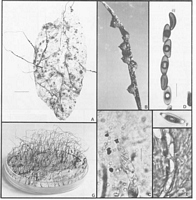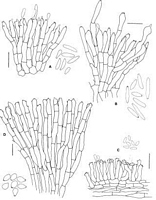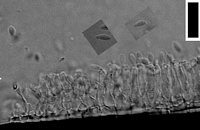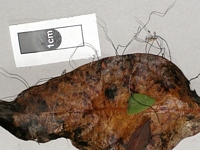|
 Xylaria filiformis Xylaria filiformis
SynonymsSphaeria filiformis
BiostatusAbsent from region
Images (click to enlarge)
Caption: Fig. 16 Xylaria cf. filiformis A, Stromata on a leaf (PDD 44282). B, Stromal surface
(PDD 44280). C, D, Ascal ring and ascospores (PDD 44282). E, Immature ascospores
with basal appendage in an ascus (PDD 44282; Melzer's reagent; darkfi | 
Caption: Fig. 20 Xylaria anamorphs A, X. hypoxylon (PDD 45372 from nature). B, X. cf. berkeleyi
(PDD 44421 from culture). C, X. cf. filiformis (PDD 44321 from nature). D, X. theissenii
var. macro | 
Caption: scale = 10um. Conidiophores and conidia on stipe surface.
Owner: J.A. Cooper | 
Owner: J.A. Cooper | |
Article: Rogers, J.D.; Samuels, G.J. (1987) [1986]. Ascomycetes of New Zealand 8. Xylaria. New Zealand Journal of Botany 24(4): 615-650 (http://www.rsnz.org/publish/abstracts.php).
Description: Stromata solitary and scattered, unbranched, 310 cm long filiform, < 0.5 mm diam., at first
conidiogenous; perithecia intercalary, solitary or clustered, elevations distinct, (300-)500-700 µm diam.,
each perithecium opening through a minute papilla. Surface dark brown to
black, wrinkled, continuous with surface of axis, glabrous. Asci 165-170 µm total length x
(5.5-)6.0-8.0(-10.0) µm, sporiferous portion (85-)90-116(-135) µm, cylindrical; apical
ring J+, wedge-shaped, 3 µm high x 2.5-3.0 µm wide; asci 8-spored, ascospores uniseriate
with overlapping ends. Ascospores (12-)13-16(-21) x 5-7(-8) µm, inequilateral with one
flat to concave side and one round side, elliptic in top view; transparent brown, slit full
length or slightly less than full length, parallel to long axis of ascospore. Conidiophores
form in vivo along the entire length of the filiform stroma. Conidiophores forming a
compact palisade; conidiogenous cells cylindrical, 15 µm long x 2-3 µm wide, hyaline,
smooth; conidiogenous loci terminal, with refractive, frill-like scars c. 0.5 µm diam.
remaining after conidial dehiscence. Conidia (3.0-)3.8-4.8(-5.0) x (1.5-)1.7-2.0(-2.3) µm,
ellipsoidal with a truncate, refractive or non-refractive base, hyaline, smooth.
CHARACTERISTICS IN CULTURE: Colonies grown 1 week on OA at 18-20°C, 12 h
darkness/ 12 h near ultraviolet + cool white fluorescent light 5 cm diam., flat and nearly
invisible with scant aerial mycelium but with scattered, salmon stromaatc fundaments
beginning to form. Stromata forming abundantly throughout the colony within 2 weeks,
eventually attaining 5 cm x 0.5 mm diam., filiform, unbranched, acute, black, remaining
sterile.
Habitat: HABITAT: On decaying leaves of dicotyledonous trees; less often on other herbaceous
debris.
Distribution: DISTRIBUTION: (numbers of specimens examined in parentheses). NORTH ISLAND:
Northland (6), Auckland (4), Taranaki (1). SOUTH ISLAND: Nelson (1), Westland (1).
Notes: Our concept of X. cf. filiformis is similar to that of Saccardo (1882) and most other
authors. The original application of the name is uncertain and confusing, as Dennis (1958)
has made clear. Nonetheless, there appear to be numerous separate taxa that need to be
considered on a worldwide basis before the status of X. cf. filiformis and several other names
can be fully understood.
New Zealand collections of X. cf. filiformis are morphologically identical to a Daldini
specimen from Switzerland (PDD 38759; LO) and morphologically and culturally identical to
some collections from Japan (PDD 44499. 44512). Unfortunately, the cultures derived from
New Zealand collections of this species expired before we were able to photograph them. The
culture illustrated in Fig. 16 G was derived from one of the Japanese collections. A
morphologically similar fungus from a fern rachis in Japan (PDD 44510) had ascospores
25-26 x 7-9 µm, but we were unable to culture it.
The following species (Xylaria taxonomic species 1 and 2) represent taxa that are
distinct from the present concept of X. cf. filiformis but we hesitate to name them given
the existing uncertainty in application of the name X. filiformis.
|